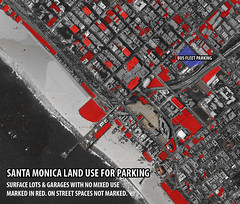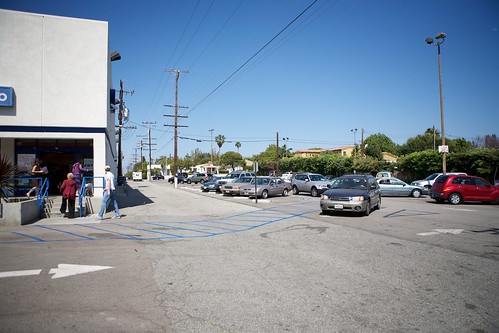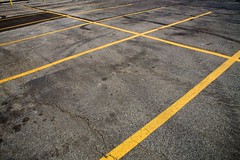Parking has been dominating the public policy debate in Santa Monica the past few weeks, ever since the local lobbying group Santa Monica Coalition for a Livable City (SMCLC) made transportation consultant Jeffery Tumlin into a target. Unfortunately they subsequently succeeded in having him removed from Santa Monica projects after years of great work with city planning efforts including our Bike Action Plan.
The open letter against Tumlin created a stir about the use of the word "nimby" on his website biography, which Tumlin used to characterize the discussion around development in Santa Monica prior to the LUCE process, and has since apologized for. However, that comment had been on the website for years while Tumlin worked on Santa Monica planning projects, as Frank Gruber points in his recent post on the history underlining this whole matter.
The controversy over using the word nimby was most likely a convenient pretense for the real reason SMCLC wanted him gone: he has been pitching ideas to reform our outdated parking policies. Reform ideas which groups like SMCLC have depicted as radical, unfortunately contributing to the local media lens on this issue, which so often adopts or promotes the language of status quo advocates. Paul Barter of Reinventing Parking makes a a compelling case "it is the status quo that is extreme" in Santa Monica and most of the USA.
Looking back over the SMCLC letter, there is the line "...we are concerned by Mr. Tumlin's proposal to decrease the amount of parking required by new developments in our city-- this in spite of residents asking for MORE parking not less...". One could also just as forcefully assert that residents have asked for less traffic congestion, perhaps even more loudly than for more parking. These two goals are at odds with each other in most contexts, especially locations as popular as Santa Monica.
This is symptomatic of the "have our cake and eat it too" approach to traffic management so often advocated. Of course we cannot have everything we want simply because we want it. Real life involves trade offs. So despite having high parking minimums for decades, a sort of individual mandate for cars, on-street traffic only got more congested. If we build parking spaces faster than we build housing units, as has been the case for quite sometime and which high parking minimums ensure, it really shouldn't be surprising that streets fill up with cars and that the scale of our parking lots dwarfs our parks for people.
When I look at the backlash to eliminating or even just dialing back parking minimum zoning, I encounter a lot of mistaken ideas about the proposals. One of the most egregious misinterpretations I encounter is believing that somehow dialing back the mandate is a grab for people's existing parking. The reality is that removing or lowering the mandate is more akin to saying some developments in the future may build fewer parking spaces than one's built since the 80's, but would not be obligated to.
Another common misconception is that getting rid of parking minimums would result in a flood of new residential, commercial and mixed used buildings without any car parking and all of the residences would attract spill over curb parking demand in the street. Lowering or removing parking minimums would not force developers to provide less, unless parking maximums were adopted, an entirely different concept.
The city of Zurich Switzerland has employed parking maximums rather than minimums for quite some time. Zurich gradually over the years constricted the supply of inner city parking with a hard total cap, to clear then worsening traffic congestion, and make space for other street users. Initial skepticism gave way to majority public support in the most recent policy updates, following the success of earlier iterations of the measures. The Zurich example adds significant strength to the case that parking management is traffic management, which Tumlin had been advocating for Santa Monica.
As for the spill over concerns, that issue is most effectively managed on it's own through residential permitting and metering. As long as curb space is a free for all (and there are few such places left in the city), or highly undervalued, than even when off-street parking is provided, many drivers still seek out curb space. Without a sufficient price signal or barrier to entry, there will always be those who wander around for blocks for the prime free space while entire decks of parking sit largely empty at or near their destination.
At 401 Broadway we saw that a mixed use residential development proposal can get through the public process and codes without any onsite parking at all, which is already allowable downtown but is not something any have tried to do in many years. Meeting the public hurdle does not mean it will get built.
The financial institutions and banks which lend for real estate development construction are their own moderating entities. Banks tend to be conservative, and especially now with so many speculative ventures going bust in recent memory. Ideas that are newer or cutting edge for a given area, are typically not what most banks are interested in. Unfortunately, they rejected the bike parking only 401 Broadway proposal insisting car parking be added despite the difficulties of providing it at the constrained site.
The absence of government compulsion to build parking wouldn't change the fact units with parking command more rent (to the detriment of the car-free) or net higher sale prices. Many people for the immediate foreseeable future will still want a place to park and will vote with their dollars for those who provide it. As Matt Yglesias somewhat comically put it recently, "...we do not mandate that apartments have mattresses included, and yet mattresses sell quite well because people are willing to pay extra for a soft surface to sleep on."
Removing or dialing back the minimums allows market experimentation with tweaked business models. Ones that can start to serve clients that are now often undeserved (including car-free or 1 car households). Most of what would be built would likely be along familiar lines until some test cases start proving the waters first.
Reform would mean that older apartment buildings, including the one I live in currently and enjoy very much, would be legal to build again, offering a more affordable alternative to the more expensive parking heavy developments. It may also make conversions of commercial properties to residential or mixed use more attractive and more affordable, which could go a long way toward addressing the imbalance of insufficient housing for the size of our workforce.
The changing needs of the present, and the compelling and plausible shifts on the horizon in the foreseeable future, require a rethink of our approach to parking, and no amount of wishful thinking is going to change that. If we are as serious about sustainability in Santa Monica as we like to claim to be, there simply is no getting around the need to stop forcing automobile-centrism onto the landscape.











